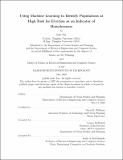| dc.contributor.advisor | Sarah E. Williams. | en_US |
| dc.contributor.author | Tan, Jialu. | en_US |
| dc.contributor.other | Massachusetts Institute of Technology. Department of Urban Studies and Planning. | en_US |
| dc.contributor.other | Massachusetts Institute of Technology. Department of Electrical Engineering and Computer Science. | en_US |
| dc.date.accessioned | 2020-09-21T16:42:05Z | |
| dc.date.available | 2020-09-21T16:42:05Z | |
| dc.date.copyright | 2020 | en_US |
| dc.date.issued | 2020 | en_US |
| dc.identifier.uri | https://hdl.handle.net/1721.1/127660 | |
| dc.description | Thesis: M.C.P., Massachusetts Institute of Technology, Department of Urban Studies and Planning, May, 2020 | en_US |
| dc.description | Thesis: S.M., Massachusetts Institute of Technology, Department of Electrical Engineering and Computer Science, May, 2020 | en_US |
| dc.description | Cataloged from the official PDF of thesis. | en_US |
| dc.description | Includes bibliographical references (pages 89-93). | en_US |
| dc.description.abstract | Homelessness in the U.S. emerged as a social problem from the beginning of the last century and has persisted until today. Even though multiple projects like the McKinney Act have created channels of funding for homelessness and homeless services have been improved greatly, the homeless population continues to grow. Eviction, which has been proved by research to have a strong correlation with homelessness, is getting more attention in recent years. The U.S. government has also shifted strategies from providing emergency care to the homeless population to implementing preventive strategies for eviction like providing rent subsidies and affordable housing units. In order to help the preventative programs to better allocate resources and to target the most urgent regions in San Francisco, this thesis applies statistical models (regression and machine learning) to predict eviction and identify highly correlated predictors for eviction. It compares the performance of Random Forest and Recurrent Neural Networks to the linear regression model. Using these findings, this thesis discusses proactive actions that can be implemented in San Francisco, including reaching out to the populations at high risk and planning government budgets based on predicted evictions. | en_US |
| dc.description.statementofresponsibility | by Jialu Tan. | en_US |
| dc.format.extent | 93 pages | en_US |
| dc.language.iso | eng | en_US |
| dc.publisher | Massachusetts Institute of Technology | en_US |
| dc.rights | MIT theses may be protected by copyright. Please reuse MIT thesis content according to the MIT Libraries Permissions Policy, which is available through the URL provided. | en_US |
| dc.rights.uri | http://dspace.mit.edu/handle/1721.1/7582 | en_US |
| dc.subject | Urban Studies and Planning. | en_US |
| dc.subject | Electrical Engineering and Computer Science. | en_US |
| dc.title | Using machine learning to identify populations at high risk for eviction as an indicator of homelessness | en_US |
| dc.type | Thesis | en_US |
| dc.description.degree | M.C.P. | en_US |
| dc.description.degree | S.M. | en_US |
| dc.contributor.department | Massachusetts Institute of Technology. Department of Urban Studies and Planning | en_US |
| dc.contributor.department | Massachusetts Institute of Technology. Department of Electrical Engineering and Computer Science | en_US |
| dc.identifier.oclc | 1183396831 | en_US |
| dc.description.collection | M.C.P. Massachusetts Institute of Technology, Department of Urban Studies and Planning | en_US |
| dc.description.collection | S.M. Massachusetts Institute of Technology, Department of Electrical Engineering and Computer Science | en_US |
| dspace.imported | 2020-09-21T16:42:03Z | en_US |
| mit.thesis.degree | Master | en_US |
| mit.thesis.department | UrbStud | en_US |
| mit.thesis.department | EECS | en_US |
